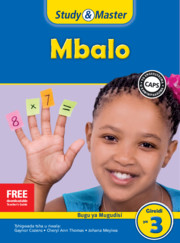Bugu ya vhadededzi i katela: mishumo yo engedzwaho ya kilasini u divhadza na u tanganyisa mushumo wo itwaho kha bugu ya vhagudiswa na bugu ya mishumo, tshivhudzo dza u funza na thikhedzo ya mishumo i re kha materiala ya vhagudiswa, thuso kha mishumo yothe ya kilasini, u funza tshigwada tshituku, na u di itela mushumo, ufoda mabambiri a u nwala maraga na bammbiri la tsumbo dza zwivhumbeo.
Table of Contents
- Part 1: Introduction
- Weekly teaching schedule
- Phase overview
- Part 2: Planning
- A suggested flow for the Mathematics lesson
- Assessment
- Photocopiable sheets
- Part 3: Lesson-by-lesson
- 1. Counting
- 2. Number symbols and number names
- 3. One and many
- 4. More and less
- 5. One more and one less
- 6. Ordering numbers
- 7. Odd and even numbers
- 8. Describe and compare numbers
- 9. Number concept: Addition and subtraction
- 10. Sharing
- 11. Grouping and repeated addition
- 12. Shopping
- 13. Doubling and halving
- 14. Mental calculations
- 15. Problem solving
- Content area/Module 2:
- Patterns, functions and algebra
- 1. Number patterns
- 2. Geometric irc patterns
- Content area/Module 3: Shape and space
- 1. Describing 3-D objects
- 2. Position and direction
- 3. 3-D objects
- 4. Sorting 3-D objects
- 5. Building 3-D objects
- 6. 2-D objects
- 7. Symmetry
- Content area/Module 4
- Measurement
- 1. Time of the day
- 2. Days of the week, months of the year
- 3. Mass
- 4. Capacity
- 5. Length
- Content area/Module 5
- Data handling
- 1. Concepts and skills
- Part 4: Teaching aids
- Part 5: Documents.
Advice on useful tools
Advice on useful tools, activities and timetabling from teachers experiencing school closures.
Cambridge GO
All our supporting resources have now moved to Cambridge GO – the new home for your Cambridge digital content.
Listen to our podcast
Listen to our podcast to discover teaching inspiration & advice from leading educational thinkers.




